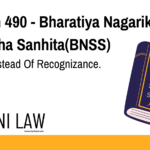Code: Section 96 – Bharatiya Sakshya Adhiniyam, 2023
When the language used in a document is, on its face, ambiguous or defective, evidence may not be given of facts which would show its meaning or supply its defects.
Illustrations:
(a) A agrees, in writing, to sell a horse to B for “one lakh rupees or one lakh fifty thousand rupees”. Evidence cannot be given to show which price was to be given.
(b) A deed contains blanks. Evidence cannot be given of facts which would show how they were meant to be filled.
Explanation of Section 96 BSA
Section 96 of the Bharatiya Sakshya Adhiniyam restricts the use of extrinsic evidence when the language of a document is patently ambiguous or incomplete. That means if the document itself is unclear or defective on its face, external facts cannot be introduced to resolve or fill in the ambiguity.
This section applies where:
-
The ambiguity is apparent from the document itself (not arising from its application to facts).
-
The defect or gap in the document is such that no amount of external clarification can determine the intent with certainty.
Objective:
To protect the integrity of written documents and prevent courts from rewriting or modifying terms that are incomplete or inherently unclear.
Illustration
Here are two practical examples that clarify the application of this section:
-
Example (a): A contract states that a horse is to be sold for “₹1,00,000 or ₹1,50,000”. Since the document provides two different amounts and does not specify which is correct, no external evidence can be admitted to determine the agreed price.
-
Example (b): A legal deed has unfilled blanks. External evidence cannot be used to explain what was intended to go in those blanks.
Common Questions and Answers on Section 96 BSA
Q1. What is meant by “ambiguous or defective” on the face of a document?
It means the document contains language that is unclear, contradictory, or incomplete, such that it is not possible to ascertain the parties’ intent by reading the document alone.
Q2. Can parties introduce oral or written evidence to clarify such a document?
No. If the ambiguity or defect is apparent from the document itself, Section 96 bars the admission of any external evidence to interpret or amend it.
Q3. Is this different from a latent ambiguity?
Yes. A latent ambiguity (covered in Section 97) arises only when the document is applied to external facts. In those cases, external evidence may be allowed. But Section 96 deals with patent ambiguity, which is clear from the face of the document itself.
Q4. What if a party left a blank by mistake?
Even if the omission was accidental, under Section 96, evidence cannot be introduced to explain what was meant unless the mistake qualifies under exceptions provided in other sections (e.g., fraud or mutual mistake, as covered in Section 95).
Conclusion
Section 96 of the Bharatiya Sakshya Adhiniyam plays a crucial role in maintaining the sanctity of written agreements. It prevents parties from correcting or clarifying ambiguous or incomplete documents after execution through oral evidence. While this may seem rigid, it encourages diligence in drafting and signing contracts and legal documents.
If you’d like, I can assist with generating internal links for related sections (like Section 95 or Section 97) based on your website’s structure.











